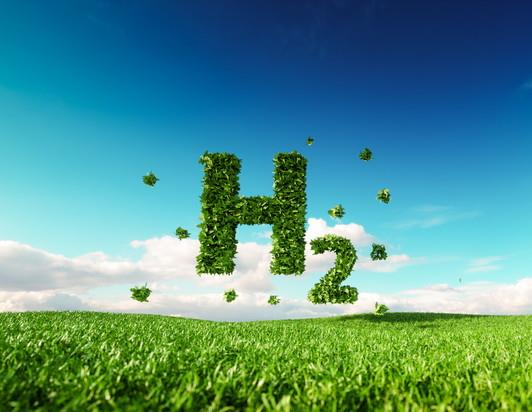Hydrogen is the most abundant element in our solar system, making up around 75%. Green hydrogen and its derivatives are considered a key technology for a successful energy transition and reducing carbon dioxide emissions. The National Hydrogen Strategy, adopted on June 10, 2020, is one political measure for a successful market ramp-up.
Hydrogen color theory – different types of production
Hydrogen is assigned different colors depending on how it is produced. There is gray, blue, turquoise and green hydrogen. Gray hydrogen is considered the cheapest but the most environmentally harmful variant, as it is produced by steam reforming natural gas. Blue hydrogen is produced in the same way as gray hydrogen. In contrast to gray hydrogen, however, up to 90% of the CO2 produced is captured and stored in blue hydrogen. Turquoise hydrogen is produced through methane pyrolysis via thermal decomposition of methane (CH4) – a process that is still under development. Green hydrogen is set to play an essential role in the future. Sustainably generated electricity, for example, from solar and wind power, is used in electrolyzers to produce hydrogen from water. In this process, water (H2O) is split into hydrogen and oxygen.
Areas of application for hydrogen
Today, hydrogen is mainly used in the chemical, petrochemical, and steel industries. Examples include ammonia production for fertilizers and oil processing in refineries. Therefore, Green hydrogen can help reduce CO2 emissions in many industries. At the same time, it makes a valuable contribution to the transformation of many industries and numerous production processes by substituting fossil raw materials.
However, the potential uses of green hydrogen are wider than industrial applications. Green hydrogen also offers mobility and potential in the energy industry. Compared to battery electric vehicles (BEV), vehicles with H2-based drive technologies (fuel cell or H2 combustion engine) stand out regarding refueling speed and range. Furthermore, hydrogen-based drive technologies also open up new opportunities for climate-neutral mobility development in the heavy goods and transportation sector, on the railways, and in maritime and aviation applications. Green hydrogen can also produce synthetic fuels for conventional combustion engines.
Fuel cells can convert stored hydrogen into electricity and provide electricity on demand. This is always the case when electricity generation from wind and solar energy is too low compared to the electricity demand. The heat generated during the fuel cell operation can be used for heating purposes in the sense of combined heat and power (CHP).
Gas pipelines are already being rededicated to developing a hydrogen supply structure. By converting the supra-regional transport pipelines and urban gas pipelines, hydrogen can be transported directly to the consumer. The advantage is obvious. New infrastructure investments are lower and the impact on nature caused by new pipeline routes is minimized.
Expansion of production capacities in Germany
In Germany, green hydrogen is seen as one of the key elements in reducing CO2 emissions. The share of green hydrogen is around 5% of the total annual hydrogen production of approx. 55 TWh to 60 TWh. The majority of hydrogen is classified as gray depending on the form of production.
Studies on the future demand for hydrogen produced from electricity using electrolysers classify hydrogen demand into low and high scenarios. In the Fraunhofer hydrogen roadmap, the range of demand in 2030 is given as 4 TWh in the low scenario and 20 TWh in the high scenario. For the year 2050, demand is estimated at 250 TWh in the low scenario and 800 TWh in the high scenario. This amount is to be covered by domestic production and imports. The energy required for domestic production is to be obtained primarily from wind energy and photovoltaic systems. Considerable efforts will be required to achieve this goal. This is because production capacities for green hydrogen are still limited, as both green electricity sources and electrolysis capacity need to be expanded.
Global potential for green hydrogen production
From a global perspective, there is significant potential for sustainable hydrogen production on the African continent. Forecasts in the German Federal Ministry of Education and Research’s “Hydrogen Potential Atlas” estimate annual production volumes of green hydrogen of up to 165,000 TWh for West Africa alone. Favorable solar radiation and wind conditions enable production costs that, according to the Potential Atlas, allow for 120,000 TWh at less than € 2.50 / kg H2 (forecast for Germany in 2050: € 3.80 / kg H2). The main influencing factor is the 30% lower electricity generation costs compared to Germany. Valuable synergy effects can arise for Germany and Europe in cooperation with Africa.
A study on international hydrogen strategies commissioned by Weltenergierat – Deutschland e.V. also shows the high level of interest in hydrogen. In this study, the growing number of hydrogen strategies is seen as an indication of dynamic market growth. Among the world’s strongest economies, 20 countries have already adopted a national hydrogen strategy or are in the process of doing so.
Project examples in Germany
Several green hydrogen projects are currently being planned and under construction. For example, Bavaria’s largest electrolysis plant is being built in Wunsiedel. The plant with an electrolysis capacity of 8.75 MW is being realized in a cooperation between Siemens AG, the gas supplier Rießner Gase and the Wunsiedler Stadtwerks SWW. It is scheduled to go into operation in summer 2022. The planned production capacity for hydrogen will amount to around 1,350 tons of hydrogen per year. It will be distributed by trailer to industrial customers in northern Bavaria, Thuringia and the border region of the Czech Republic.
An innovative energy park is currently being built in Germany near the Goethe town of Bad Lauchstädt (Saale district) in Saxony-Anhalt as part of the funded real-world laboratory programs. The innovative nature of the project is a first. For the first time, the networking of a wind farm (nominal output 50 MW) with a large electrolysis plant (nominal output 30 MW) is being tested, accompanied by the conversion of a gas pipeline for hydrogen transport and the marketing of the hydrogen. In a further phase, the hydrogen is to be stored in a salt cavern. Completion and commissioning are planned for 2024. You can find more information about the Bad Lauchstädt energy park here.
The authors are employed by greenValue GmbH. greenValue is a service company in the field of renewable energies with many years of experience and extensive references, including in the area of project management.
greenValue GmbH
Zeltnerstraße 3
90443 Nuernberg
Germany
Phone: +49(0)911-507166-0
E-Mail: info@greenvalue.de
Web: www.greenvalue.de
Twitter: twitter.com/greenvalue02
Instagram: instagram.com/greenvalue_gmbh
Source: 01 July 2022, www.greenvalue.de


